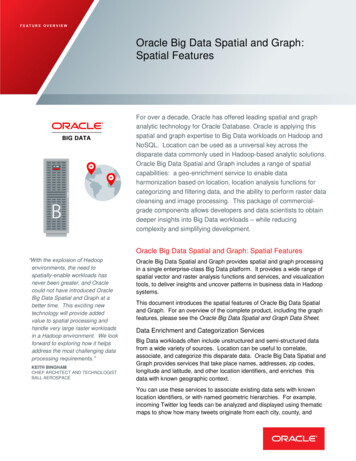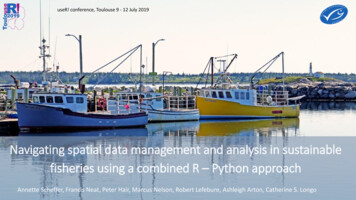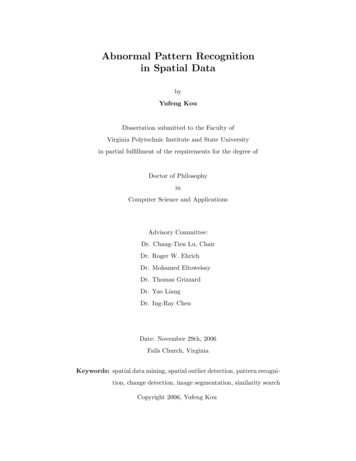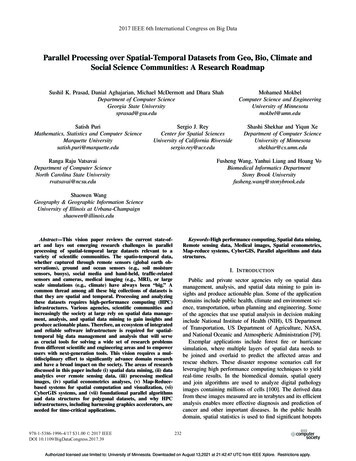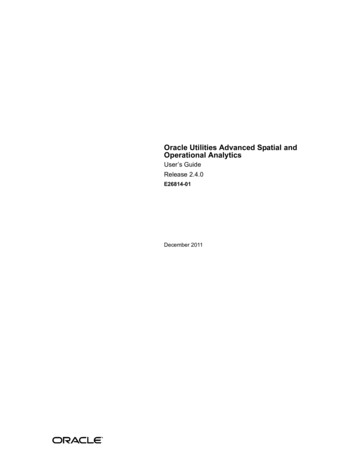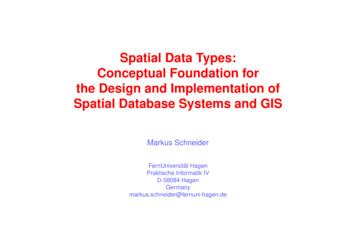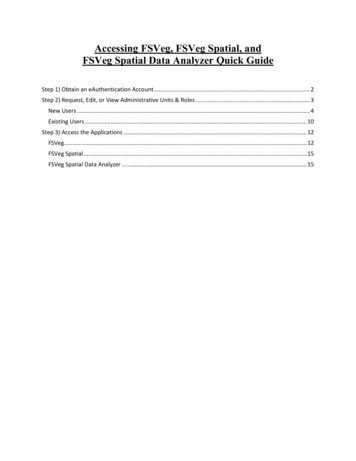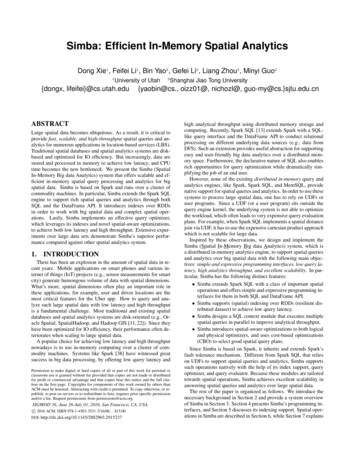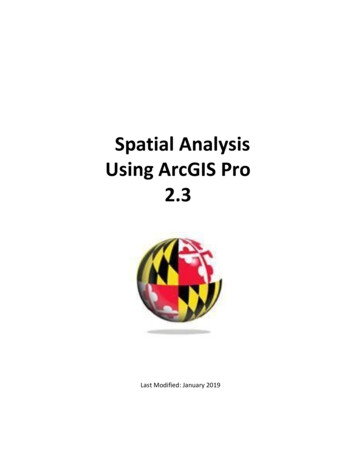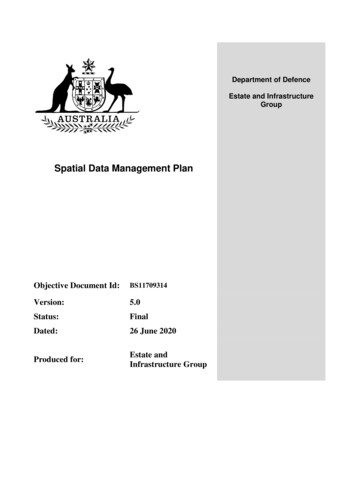
Transcription
Department of DefenceEstate and InfrastructureGroupSpatial Data Management PlanObjective Document Id:BS11709314Version:5.0Status:FinalDated:26 June 2020Produced for:Estate andInfrastructure Group
Spatial Data Management PlanEXECUTIVE SUMMARYThe Estate and Infrastructure Group (E&IG) Spatial Data Management Plan (SDMP) hasbeen developed to provide standards and specifications for spatial data management. TheSDMP and Estate Register Information Model (ERIM) make up the Defence EstateDictionary (DED), which defines all requirements for information collection, storage andmaintenance for the Defence estate.The standards and specifications within the SDMP will improve data quality and availabilityof information and facilitate spatial information dissemination and sharing within E&IG. Withits use under the E&IG Information Management Framework, E&IG will achieve astandardised approach to spatial data management that will realise many benefits to both theorganisation and its staff including: Consistent and more reliable data that will lead to more informed decision making;Closer integration with E&IG information systems and Defence spatial data users;Portability of staff skills; andGreater interoperability with organisations outside of Defence.The SDMP shall be used by spatial Data Supplier and Business Managers both withinDefence and Defence Contractors, and Information Stewards within E&IG. It is theresponsibility of Data Suppliers and Business Managers to implement the SDMPSpecifications and produce data in accordance with the specifications. Data Suppliers andBusiness Mangers shall implement all requirements defined in Section 2, and the specific datarequirements in Sections 3 onwards as determined by the type of data to be created orupdated. Information Stewards will adhere to the standards and requirements set out inSection 2 and Section 3 when managing data with relationship to spatial data.The SDMP is made up of three main Sections:Section 1 provides an introduction to the SDMP, the scope of implementation and otherbackground information to the document including how this requirement integrates with theoverarching DED.Section 2 contains the General Data Specification that describes data formats, file namingconventions, metadata requirements, the approved datum and coordinate systems,measurement units, accuracy and other E&IG data standards.Sections 3 onwards contain a set of specific data type specifications that shall be implementedby all spatial Data Suppliers, Business Managers and Information Stewards. The dataspecifications cover the key E&IG data types: the Master Site Plan and the Spaces (Floor)Plans, in addition to specifications for engineering detail survey, aerial photography, masterplanning, environmental data and other data types.Appendices support the SDMP, providing detail of the E&IG Spatial Data ManagementSpecifications, the full Metadata Specification and additional appendices to support the coredata specification and data type specifications. Table E-1 summarises the information heldwithin each Section and Appendix.This version of the SDMP coincides with the release of geo-enablement functionality in theGarrison and Estate Management System (GEMS).Version 5.0ii26 June 2020
Spatial Data Management PlanThe opportunity has also been taken to provide clarification of issues identified by SDMPusers in this release.Version 5.0iii26 June 2020
Spatial Data Management PlanTable E-1 SDMP Sections and AppendicesSDMPSectionSection 1Section 2Section 3Section 4Section 5Section 6Section 7Section 8Section 9Section 10Section 11Section 12Section 13Section 14Section 15Appendix AAppendix BAppendix CAppendix DAppendix EAppendix FAppendix GAppendix HAppendix IAppendix JAppendix KAppendix LAppendix MAppendix NDescription of ContentsIntroductionData SpecificationMaster Site Plan DatasetsSpaces Plan DatasetsReference DataEngineering Detail Surveyfor Infrastructure and AssetsLand Management DataCommunications DataAerial PhotographySatellite ImageryMaster Planning DatasetsContaminated Sites DataEnvironmental DataHazards DataGEMS Geo-enabled ObjectsGlossaryReferencesContaminated Sites Data Standards - retiredMetadata SpecificationDirectory StructureScale and AccuracyMaster Site Plan AutoCAD StandardsSpace Plan StandardsLand Management Data StandardsMaster Planning CAD StandardsEnvironmental Data ModelSpace Plan Labelling Standards - retiredHazards Spatial Data StandardsGEMS Geo-Enabled ObjectsA set of template datasets are provided as part of the SDMP to assist in the implementation ofthe SDMP specification. The templates are available on the Defence Estate QualityManagement System (DEQMS) and include example data that has been collected inaccordance with the SDMP specifications.Version 5.0iv26 June 2020
Spatial Data Management PlanTABLE OF CONTENTSExecutive SummaryiiTable of ContentsvVersion History1xiiIntroduction11.1Defence Estate Information . 11.2GEMS and the Defence Estate Dictionary. 11.3Purpose of SDMP . 21.4Spatial Data Definitions . 31.5Intended Audience . 41.6Structure of SDMP . 41.7Application of the SDMP. 61.8SDMP Point of Contact . 81.9Linkages with NSIMS. 81.10 Spatial Data in the E&IG Information Management Framework . 82General Data Specification122.1Introduction . 122.2Data Format . 122.3File Names . 142.4Directory Structures . 142.5Spatial Metadata. 142.6Datum. 152.7Coordinate Systems . 162.8Units of Measurement . 172.9Spatial Accuracy . 172.10 Spatial Scale . 172.11 Data Capture . 18Version 5.0v26 June 2020
Spatial Data Management Plan2.12 Data Viewing . 182.13 Spatial Integrity of Features - Topology . 182.14 Spatial Integrity of Features – Topology in a CAD Environment . 202.15 Data Attributes . 222.16 Imagery Management – Image Tiling. 222.17 Hardcopy Archival . 232.18 Vectorisation of Scanned Information . 243456Master Site Plan Datasets283.1Scope of Specification . 283.2Deliverables . 293.3Deliverable Templates . 293.4Data Deliverable Specification . 293.5Specific Data Requirements . 31Spaces Plans344.1Scope of Specification . 344.2Deliverables . 354.3Deliverable Templates . 354.4Required Inputs . 354.5Data Deliverable Specification . 354.6Specific Data Requirements . 36Reference Data455.1Scope of Specification . 455.2Deliverables . 455.3Deliverable Specification – General Reference Documentation . 455.4Deliverable Specification – Design Drawings . 46Engineering Detail Survey for Infrastructure and Assets6.1Version 5.050Scope of Specification . 50vi26 June 2020
Spatial Data Management Plan789106.2Deliverables . 506.3Data Inputs . 506.4Deliverable Specification . 506.5Specific Data Requirements . 51Land Management Data547.1Scope of Specification . 547.2Deliverables . 547.3Deliverable Templates . 557.4Specific Data Requirements . 55Communications Data588.1Scope of Specification . 588.2Deliverables . 588.3Deliverable Templates . 588.4Required Inputs . 598.5Specific Data Requirements . 598.6Field Capture. 598.7Data Capture . 59Aerial Photography669.1Scope of Specification . 669.2Deliverables . 669.3Acquisition Requirements . 669.4Orthophoto Specifications . 699.5Orthophoto Deliverables . 699.6Deliverable Specification . 709.7Quality Assurance Documentation . 729.8Specific Metadata Requirements . 72Satellite ImageryVersion 5.074vii26 June 2020
Spatial Data Management Plan10.1 Scope of Specification . 7410.2 Background Information . 7410.3 Deliverables . 7610.4 Deliverable Specification . 7610.5 Specific Data Requirements . 7711Master Planning Datasets8011.1 Scope of Specification . 8011.2 Deliverables . 8111.3 Deliverable Templates . 8111.4 Deliverable Specification . 8212Contaminated Sites Data8412.1 Scope of Specification . 8412.2 GEMS: Spatial Data Update and Creation. 8512.3 Property Contaminated Site Map Requirements. 8512.4 Data Deliverable – Map Template . 8912.5 Data Deliverable Specification . 8913Environmental Data9213.1 Scope of Specification . 9213.2 Background Information . 9213.3 Types of Environmental Spatial Data . 9213.4 Data Deliverable – Templates . 9413.5 Data Deliverable Specification . 9413.6 Specific Data Requirements . 9513.7 Map Requirements . 9513.8 External Environmental Data . 10014Hazards Data10214.1 Scope of Specification . 102Version 5.0viii26 June 2020
Spatial Data Management Plan14.2 Schedule 11 Hazardous Chemicals Data and Maps (HAZCHEM) . 10214.3 Hazardous Areas Data. 10914.4 Unexploded Ordnance (UXO) Data. 11114.5 Training Area Unexploded Ordnance (UXO) Hazard Data and Maps . 11214.6 Asbestos . 11615GEMS Geo-Enabled Objects (Features)11815.1 Scope of Specification . 11815.2 Approaches for Geo-Enablement of Objects (Features) . 11815.3 How Geometries are Created or Updated for Geo-enabled Objects (as GISfeatures). 11815.4 Data Deliverable Specification . 120TablesTable 1-1 SDMP User Groups . 4Table 1-2 SDMP Sections and Appendices . 5Table 1-3 Principles of the E&IG Spatial Data Policy. 9Table 2-1 List of Specialised Data Specifications . 12Table 2-2 E&IG Spatial Data Formats . 13Table 2-3 Recommended Tile Sizes. 22Table 3-1 Scope of Master Site Plan Data . 28Table 4-1 Space Area Layers . 42Table 4-2 Spaces Plan Block Attributes . 42Table 4-3 AutoCAD Block Space - Attributes. 43Table 5-1 Example ASCON File Names . 46Table 5-2 Design and As-Constructed Title Block Requirements . 47Table 5-3 Design and As-Constructed Title Block Optional Information . 47Table 6-1 Scope of Data Collected using Engineering Detail Survey . 50Table 7-1 Land Management data types . 54Table 7-2 Land Management data type GEMS Record Requirements . 55Table 8-1 Communication Pit Data . 61Table 8-2 Communications Conduit Data . 62Table 8-3 Communication Cable Data . 63Table 8-4 Communications Conduit Cable Link Data . 64Table 9-1 Orthophoto Options for Resolution and Accuracy . 70Table 9-2 Orthophoto Technical Specifications. 70Table 9-3 Orthophoto Quality Assurance Plan . 72Table 9-4 Aerial Photography Specific Metadata Requirements . 72Table 10-1 Satellite Imagery Specific Metadata Requirements . 77Table 12-1: Contaminated Datasets . 84Table 12-2: Function Codes . 85Table 12-3: Property Contaminated Sites Map Presentation Guidelines . 86Version 5.0ix26 June 2020
Spatial Data Management PlanTable 13-1: Bushfire Operations Map Presentation Guidelines. 96Table 13-2: Land Capability Map Presentation Guidelines . 98Table 14-1: Schedule 11 Hazardous Chemicals Workplace Site Map Presentation Guidelines. 105Table 15-1: Objects geospatial enabled via attribute association with other GEMS Objects 118Table 15-2: Methods for Creation of Geometries for Geo-Enabled Objects . 119FiguresFigure 1-1 Master Site Plan Dataset - example data . 3Figure 1-2 Spaces Plan Dataset - example data . 4Figure 1-3 Specification Process Flow Diagram. 7Figure 2-1 Examples of Correct Topological Representation . 19Figure 2-2 Examples of Correct Topological Representation . 20Figure 2-3 Incorrect Topology - Unconnected line and point features . 21Figure 2-4 Correct Topology - Connected line and point features . 21Figure 3-1 Master Site Plan Dataset - example data . 29Figure 4-1 Spaces Plan Dataset - example data . 34Figure 4-2 Example external space capture of a covered area . 37Figure 4-3 Example wet area and ablutions as a single space . 38Figure 4-4 Example multiple wet area and ablutions space capture . 38Figure 4-5 Example stairs in a corridor and stairwell space capture . 38Figure 4-6 Example 1- workstations or work areas space capture . 39Figure 4-7 Example 2 - workstations or work areas space capture . 39Figure 4-8 Example fire hose space capture . 40Figure 4-9 Example electrical switch/substation and communications areas space capture . 40Figure 8-1 Communication Pit Labels . 60Figure 8-2 Communication Cable Labels . 63Figure 12-1: Example Property Contaminated Sites map . 88Figure 13-1 Environmental Spatial Data Types . 94Figure 14-1: Example Workplace Site Map . 104Figure 14-2: Example Defence Training Area UXO Hazard map . 114AppendicesAppendix AAppendix BAppendix CAppendix DAppendix EAppendix FAppendix GAppendix HAppendix IAppendix JAppendix KAppendix LAppendix MVersion 5.0GlossaryReferencesContaminated Sites Data Standards - RetiredMetadata SpecificationDirectory StructureScale and AccuracyMaster Site Plan AutoCAD StandardsSpace Plan Data StandardsLand Management Data StandardsMaster Planning CAD StandardsEnvironmental Data ModelSpace Plan Labelling Standards – RetiredHazards Spatial Data 6 June 2020
Spatial Data Management PlanAppendix NVersion 5.0GEMS Geo-Enabled ObjectsxiN-126 June 2020
Spatial Data Management PlanVERSION HISTORYVersionNumberDateAmendment1.0Feb 06Draft3.031 Oct 06Published3.18 May 07Draft3.229 Feb 08Published4.5.17 Aug 08Published4.5.221 Dec 11Draft4.6.001 Mar 15Draft4.6.101 Jul 16Published4.6.225 Oct 17Published4.6.306 Feb 18Published5.026 June 2020PublishedVersion 5.0CommentBaseline version for releaseIncludes name change from CSIG to DSGUpdated SDMP Section 5 Spatial MetadataSpecifications v4.4 of 8 May 07. UpdatedSection 1 Guiding Principles to numberedparagraphs and added a Table of Contentsfor the each SDMP section.The Section 1 version number acts as theoverall version number for the entireSDMP. If any section is updated, Section 1should also be updated.Updated SDMP Section 5 Spatial MetadataSpecs v4.5, Section 6 Baseline Spatial DataSpecifications v3.1 and Section 7 SpatialData Specifications v3.1.Released ByJohn RamsayDIIEJohn RamsayDIIEJohn RamsayDIIEBerceuseBindle DIIEBerceuseBindle DIIEIncludes name change from DSG to DS.General restructure and revision of SDMPto improve currency, ease-of-use andreduce ambiguity.Update of Section 12 and Appendix C.Addition of section 14 and appendix M forinclusion of Hazards DataUpdate DSRG to E&IG, Branches andDirectorate names, and references to DEMSand RDMs. Update Appendix M Table M-7Field Name Ocean to Medium withadditional valuesUpdate Space Plan figures to clockwiseUpdate Spaces plan naming conventions,Sections 4.6.2.4, 4.6.2.5 and Annex LUpdates to reflect GEMS requirementsAppendices C & L retired.xiiBerceuseBindle DSIMRod ArmstrongVictor BebawiLisa FulgenziLisa FulgenziLisa FulgenziLois Wake26 June 2020
Section 1 Introduction1INTRODUCTION1.1Defence Estate Information1.1.1E&IG has developed and endorsed the E&IG Information Management Framework,which sets out the how E&IG Information will be governed and managed by thebusiness.1.1.2The Framework sets out seven information management principles to provide areference point by which all IM processes, decisions and outcomes can be designed,implemented and assessed.1.1.3The E&IG IM principles are: Business Led – E&IG information is an enterprise level asset - defined by theneeds of the business, not defined by the technology solution. Governed – Information assets are governed in a transparent and accountablemanner to ensure its business and authoritative value is maintained. Managed – Information assets are actively managed and maintained inaccordance with business and technical standards to ensure they are fit forpurpose, usable, and available to the business user. Organised – Information assets are structured and connected within a trustedsingle-source to enable Defence to manage and use the information according toits business requirements. Secured – E&IG information is secured against unauthorised access, change,loss or deletion in order to ensure integrity and protect sensitive information. Used – E&IG information supports enterprise-wide business processes andoperating models and is accessible to authorised business users enablinginformed business processes and decisions. Quality – E&IG information assets meet quality standards defined by thebusiness.1.1.4This SDMP is a key element of the management of data within E&IG by defining thespecific requirements by which spatial data is to be managed according to the E&IGIM Principles.1.2GEMS and the Defence Estate Dictionary1.2.1The single source of data for Estate and Infrastructure information resides in theGarrison Estate Management System (GEMS). GEMS has been implemented tosupport the effective management of the Defence Estate by Defence and its BaseServices Contractors. Estate data is maintained in GEMS and includes asset datadescribing the Defence Estate using spatial and non-spatial means.1.2.2GEMS provides timely and reliable information to support the planning and deliveryof estate infrastructure, development of the Defence capability life cycle, themanagement of estate risks and environmental compliance and the delivery of estatesupport. GEMS also provides real time exchange of electronic information betweenDefence and Defence contractors.1.2.3GEMS is enhanced with basic geo-enabled functions. Geo-enablement provides userswith an ability to visualise, contextualise and interpret GEMS information, thereby toVersion 5.0126 June 2020Section 1 - IntroductionSpatial Data Management Plan
Section 1 Introductionassure its truth and to better understand the relationships, patterns and trends forimproved Defence estate decision making. GEMS Geo-enablement involvesmandatory application of simple geometry representations that demonstrate existence,shape and location of all geo-enabled GEMS estate master records and transactions.Representative geometries are applied at creation of all master and transactional data,and these are maintained throughout the record lifecycle.1.2.4GEMS is both a creator and consumer of spatial data that is created by Defence, itsstakeholders in industry and government and also commercial sources. These data arevisualised, stored, analysed and managed within a GIS information environment thatresides both within and alongside the GEMS system.1.2.5GEMS Geo-enablement will manage business GIS layer updates via workflowtasking, the E&IG GIS will provide the workflow tasking capability (i.e. packagingand issuing data for updates).1.2.6The SDMP spatial data specifications supports GEMS geo-enablement through thealignment of key spatial dataset with GEMS Estate Business Identifiers (EBI), GEMSdata field values and Estate Register Information Model (ERIM) classes.1.2.7While the SDMP articulates the requirements for spatial data, the ERIM specifies SAPbased data requirements. As Defence has Geo enabled its SAP implementation thedata set requirements are integrated. This will eventually be reflected in the creationof one data dictionary developed consistent with the IM principles.1.2.8Refer to Section 15 GEMS Geo-Enabled Objects (features) and Appendix N forfurther details.1.3Purpose of SDMP1.3.1The Estate and Infrastructure Group (E&IG) Spatial Data Management Plan (SDMP)has been developed to provide standards and specifications for spatial datamanagement and has been developed with reference to spatial standards both withinDefence and the spatial industry.1.3.2The standards and specifications within the SDMP will improve data quality,availability of information and facilitate spatial information dissemination
Spatial Data Management Plan Objective Document Id: BS11709314 Version: 5.0 Status: Final Dated: 26 June 2020 Produced for: Estate and Infrastructure Group . Spatial Data Management Plan Version 5.0 ii 26 June 2020 EXECUTIVE SUMMARY The Estate and Infrastructure Group (E&IG) Spatial Data Management Plan (SDMP) has . Table 8-1 Communication .
